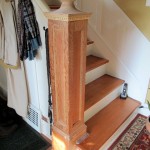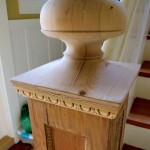For many years my stock in trade was architectural projects. One-off replacements, one of a kind pieces and whole spindle jobs, one of which was the most unique design (with every spindle being slightly different than the rest) that the particular architect involved had ever seen.
A recent customer contacted me through the this website, looking for a wood turner to turn a new top for her newel post. They are renovating an older house in Vancouver and were unable to find anyone who had the tools and the skills to make a replacement for whatever had been on the top before.
I ran a couple of designs past her; one traditional and one contemporary. They picked the contemporary design which was also my personal choice, so that always helps the job along.
The piece called for some very large wood. In days gone by, large pieces of tight grain fir
were readily available. This is a key requirement, eliminating any problems with cracking. Newels and legs of this size were always turned from the outer heartwood of trees no less than 4 feet in diameter. The grain lines at that point are almost straight so lend little stress to the equation; inner stress being the cause of all cracking and checking as the wood dries (which takes many years in this large dimension).
I had a project of my own years ago where I turned 7″ x 7″ columns (22 of ’em) for a house that I built. I bought some used Glue Lam beams and had them milled into the material I required. The newels posts were made from the same material. Being laminated wood, anything made from it is paint grade only in most cases. I had some of this stuff in my storage (you never get rid of that sort of thing) so made the newel cap from that. Because I wasn’t turning the whole newel post I had to attach the cap to the post so needed something to hide the joint. The cap was made in two pieces, the first being a transition piece from square to round having a round mortice to accept the cap or crown. This was screwed and glued to the post inside the mortice. The actual top had a round tenon that fit the mortice and was glued in with some killer glue that basically made the two into one piece of wood. I was able to get some quarter round with some embossed beading that matched the quarter round in the panels on the post, tying the whole thing together.
Thanks, Helene, for the opportunity to tackle a project that took me back to my roots.
As always, comments and criticisms are welcome.


